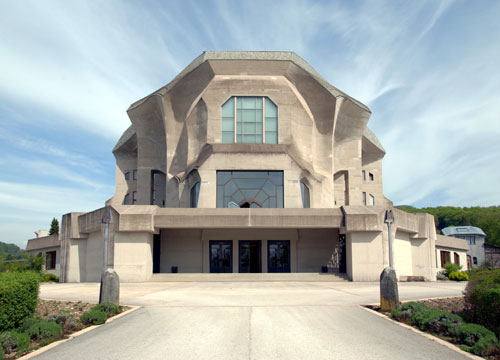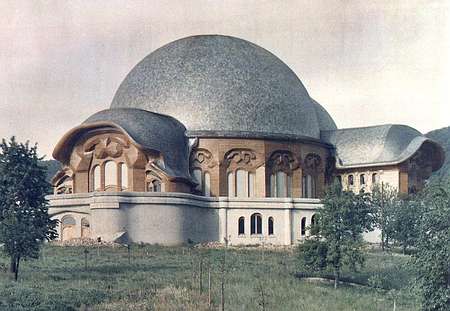The second Goetheanum opened 1928, stands in Central Europe. The main structure is of concrete. In this picture we are viewing the west facade with it's main entrance. The building was named by Steiner to honor Johann Wolfgang von Goethe (1749-1832), founder of living organic science. As a guide to scale, the three doorways are about 4 meters in height (over 12 ft.).


In this posting I hope to convey what I believe to be exemplary artworks in photos of applied universal TAO principles in artistic form. This presupposes that one views the TAO as an ever present evolving dynamic presence of interweaving cosmic and earthly forces. As above, so below... with an intermediate rhythmic-breathing dynamic which harmoniously unifies the above and below...these being the mighty heavenly forces and earthly material forces. So wouldn't it be possible that these great principles be expressed in artistic form... if mediating artists knowingly grasps the underlying principles and processes of all Divinely given creative manifestations and molds them, as in these examples, into earthly concrete form? This is the question!
To familiarize ourselves with the four main principles of TAO: oneness or wholeness, duality or polarity, tri-plicity and 'myriadness',
So how do we see these expressed in this example above?
Oneness or wholeness...It should be quite evident to the viewer that from this view at least, we can discern a total oneness of intent meaning that the entire creation expresses a unity. Here all form elements including graceful gestures and corresponding surrounding spaces are in synthesis just as an open rose bloom...or if we might we say... a symphony in synchronicity.
Duality or polarity...It is also quite clear that duality is everywhere evident...left and right, up and down and also, though we can here only view this one perspective, forward and back.
Tri-plicity...The weaving, intermediate movement we may call metamorphosis where small and large gestural forms and spaces grow organically between the great polarity of above and below as in the plant world. In the single well-formed plant form, we can observe the principle of metamorphosis where every form gracefully evolves onto another.
'Myriadness'...This means multiplying diversity, where all the small details of design organically continue. And if with the awakened loving imaginative eye of the observer, a continuation of the elements could as well be...yes...seen to go on into the 'empty' surrounding space.
The late master architect Rex Raab (1914-2004) entitled his book on the building 'Eloquent Concrete", and in my view this is a beautiful and apt title for a book on the subject. This building is one of the first examples of modern organic architecture at the beginning of the 20th century, the first in large scale be built in reinforced concrete. And it is certainly the very first monumental organic structure built out of a unversal spiritual conception. It is believed that this building inspired LeCorbusier in his designing of Ronchamp after his visit to the Goetheanum. See this link for images of LeCorbusier's chapel in France. http://www.archdaily.com/84988/ad-classics-ronchamp-le-corbusier/
and a bio about Rex Raab http://www.independent.co.uk/news/obituaries/rex-raab-6171107.html It is also known that the architects Frank Lloyd Wright as well as the world famous contemporary architect Frank Gehry have both visited this building and have, I believe been deeply influenced in various ways.
The awe inspiring first Goetheanum was utterly destroyed by fire on New Years Eve 1922-23. It was not completed. The fruits of voluntary labor by professionals as well as amateurs coming from 17 differing countries went up in flames in a single night. It stood on the very same ground as does now the second building. That original building was also sometimes referred to by Steiner as the "House of the Word" signifying an edifice that gives full expression to the Creative Word... or Logos ...or TAO...that which is a powerful present day full artistic creation out of the ground principles of existence. It was meant to be a well-spring-source of inspiration for modern humanity standing as in mighty counter-force to materialism for modern humanity and for many generations to come.
A building such as this which is created in the a threefold image of humanity of body, soul and spirit, could help to remind us of our origin, helps us to find meaning in the present and can only indicate a possible future... fulfillment of the TAO Spirit in it's furthest and highest manifestation... with the mediating, balancing tri-plicity principle: the human being. This is all a possibility with co-creative-community-building; humanity actively creative between heaven and earth, bridging our created origin with new and future creations.
More postings on these two Goetheanum buildings and 17 other structures designed by Steiner in future posts!
and a bio about Rex Raab http://www.independent.co.uk/news/obituaries/rex-raab-6171107.html It is also known that the architects Frank Lloyd Wright as well as the world famous contemporary architect Frank Gehry have both visited this building and have, I believe been deeply influenced in various ways.
The awe inspiring first Goetheanum was utterly destroyed by fire on New Years Eve 1922-23. It was not completed. The fruits of voluntary labor by professionals as well as amateurs coming from 17 differing countries went up in flames in a single night. It stood on the very same ground as does now the second building. That original building was also sometimes referred to by Steiner as the "House of the Word" signifying an edifice that gives full expression to the Creative Word... or Logos ...or TAO...that which is a powerful present day full artistic creation out of the ground principles of existence. It was meant to be a well-spring-source of inspiration for modern humanity standing as in mighty counter-force to materialism for modern humanity and for many generations to come.
A building such as this which is created in the a threefold image of humanity of body, soul and spirit, could help to remind us of our origin, helps us to find meaning in the present and can only indicate a possible future... fulfillment of the TAO Spirit in it's furthest and highest manifestation... with the mediating, balancing tri-plicity principle: the human being. This is all a possibility with co-creative-community-building; humanity actively creative between heaven and earth, bridging our created origin with new and future creations.
More postings on these two Goetheanum buildings and 17 other structures designed by Steiner in future posts!
Steiner stated that the second Goetheanum is a kind of testament or memorial to the original. This does not lessen in the least the impact and importance of the second! In some ways it 'speaks' through its presence even more emphatically and profoundly to the oncoming visitor..."Know Thyself!" These very words were in fact inscribed in Greek in the forecourt of the Temple of Apollo at Delphi, Greece. Today, in a very different time but meant with identical depth, these words call on the individual to awaken to one's true higher-self and in freedom take responsible, loving co-action in the world. "For the time is at hand!" ...from Goethe's 'Fairy Tale' for humanity The Green Snake and the Beautiful Lily.
A picture here of the original Goetheanum 1913-22 viewed from the southwest, the main structure carved out of laminated wood, roof of Norwegian slate and with the foundation base of poured concrete. The central area (under the larger dome) seated 1000 people. Read and view more about the first Goetheanum at http://en.wikipedia.org/wiki/Goetheanum
A picture here of the original Goetheanum 1913-22 viewed from the southwest, the main structure carved out of laminated wood, roof of Norwegian slate and with the foundation base of poured concrete. The central area (under the larger dome) seated 1000 people. Read and view more about the first Goetheanum at http://en.wikipedia.org/wiki/Goetheanum

No comments:
Post a Comment